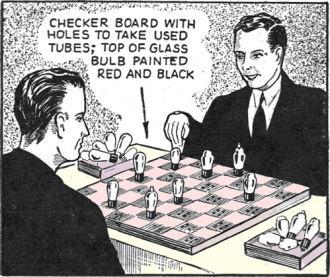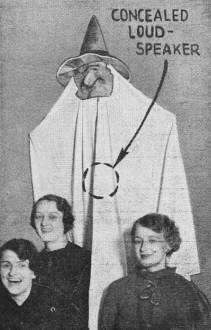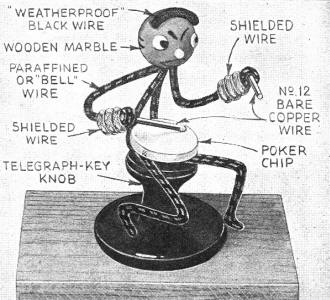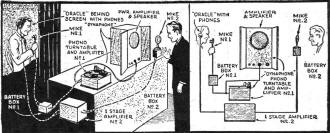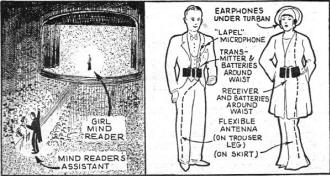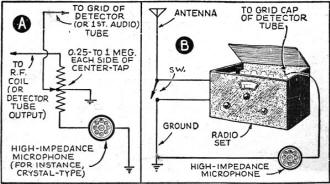Fun with Radio Parts
|
|
Making novelty items from electronics parts is nothing new. Lots of photos can be found on the WWW where very creative people have fashioned some pretty incredible electronics art items from resistors, capacitors, inductors, LEDs, PCBs, transistors, etc. Horseplay in the electronics realm also enjoys a long heritage, as illustrated in this 1937 issue of Radio-Craft magazine. I fondly recall the old days as a technician at Westinghouse Electric when, on the evening shift, we used to get away with playing practical jokes on each other in the lab. Ours were low tech stuff like connecting a high voltage supply to someone's metal toolbox or squeezing water from a soldering iron sponge wetting bottle through a length of plastic tubing (taped under a workbench) onto a guy's crotch while he was working intently on something. You'd probably get fired or sued for such shenanigans in the workplace today. Send me some of your infamous pranks and I'll be glad to post them (with or without attribution per your stipulation). BTW, 'Hallowe'en' is a legitimate alternate spelling for the more familiar 'Halloween.' The celebrated day was originally called 'All Hallows Eve,' so other forms are a shortening of the full phrase. Fun with Radio Parts By Walter Palmer Once you get started it's easy to make a "radio party." A number of clever ideas are described in this article. They range from decorations having a "radio" angle to a regular entertainment program for a house-party. Look these over and let us know whether you can add to the list. The life of the party," is what they will call the radio experimenter who exhibits a little ingenuity in applying to amusement purposes some of the simplest of radio principles, when next he entertains his friends. The fun may extend from a simple foursome of personal friends to an extensive party perhaps having a holiday tie-in. Augustina Zilch shown in Fig. A, for example, once furnished no end of hilarity for a group of Hallowe'en merrymakers composed of some well-known Chicago radio and advertising people. Augustina, the combination ghost and witch who formed a committee of one to welcome the arriving guests at this particular party, comprised certain wood fittings, a bedsheet and a loudspeaker and audio amplifier. Groans and sepulchral greetings enough to turn the hair of any ordinary person set the guests in the proper Hallowe'en mood for the evening. Ghost-Witch Zilch was placed at the entrance gate and certain members of the party located in the house gave voice to this "spirit of Hallowe'en" by remote control merely by speaking into a microphone connected to the amplifier. You may wish to apply this idea to a post-Hallowe'en" party. The possibilities of providing many unusual effects for parties of this kind are limited only by the ingenuity of host and hostess. For instance you might use an electric phonograph to reproduce a previously-recorded program of blood-curdling sound effects, in place of having hidden conspirators talking into a remote microphone; and in lieu of an effigy of sorcery an illuminated, hollowed-out pumpkin may be used to house the loudspeaker. With something of this sort as a starting point the manner of continuing the bedevilment throughout the evening becomes quite easy. "Radio" Decorations It might be well to give your next house-party a more nearly "radio" atmosphere, right at the start, by using radio parts for decorations as well as entertainment. A little thought on this subject will show just how attractive and inexpensive such party decorations can be made. For instance, I know of one radio fan who is quite successful at fashioning animals - dogs, cats, giraffes, etc. - from lengths of stiff wire. The colored hook-up wires are particularly attractive for this purpose. The wires are twisted and formed into grotesque forms which resemble (it is hoped) the animal represented. The tails are formed by untwisting the insulation and cutting off the inside wire. One radio fan, with an artistic bent, has made some fine caricatures of famous people using radio parts for the features and outlines. These caricatures are made on wooden panels which may be hung on the wills as decorations. Such parts as dials, binding posts, pilot lights, hook-up wire, etc., are used in the makeup of these amusing ornaments. "Goofey Gus," shown in Fig. B, is one example of a radio ornament that never fails to get a laugh. Other interesting ornaments made from radio parts, which I have seen, include many items that also have considerable utility. For instance, ash trays may be cut from transformer cans; table lamps from transformers, coils, tubes and other parts; etc. Radio Checkers and Chess If the group you plan to get together is sufficiently technical-minded you can spring on them the novelty of a "radio checkerboard" made as shown in Fig. 1. All you need is a piece of board and some way to mount it at the proper height for playing the game; and a set of 24 discarded tubes. If you haven't enough tubes handy the local radio repair shop probably will bless you for taking a quantity of them off its hands. To provide the "radio checkerboard" thus costs you no more than the time it takes you to get the above items together and to drill the proper number of prong holes in the board. The game is ready after you've lacquered the tubes on top; red for one player and black for the other. The same idea may be extended to chess by lettering the tops of the tubes to represent the chessmen (K, king; Q, queen; R, rook, etc.). At some more ambitious parties a "radio mind-reading act" has been put on with great success. Whether you feel like tackling the idea depends. mainly upon your ability to build a very small short-wave sending and receiving set. In any event, you'd need a transmitting license to operate the equipment; or you could get a licensed amateur to operate it for you. The general idea, illustrated in Fig. 2, is outlined as follows: Mind-Reading Act - Radio System A tiny radio transmitter made in the form of a belt worn by the "man" in the act is concealed in his clothing as he wanders about through the audience asking questions which his girl companion (blindfolded and seated at one end of the room or on the stage) answers, concerning the members of the audience. A tiny fixed-tuned receiver concealed in the girl's clothing or in the chair on which she sits provides the necessary communication to enable the acts of so-called mind reading to be performed. An inconspicuous phone unit of the type used for deaf-aids is carefully inserted in her ear with the wire slipped under her hair and down to the receiver. The actual details of transmitter and receiver may be determined experimentally by the radio man. The small "acorn". tubes or, better yet, the tiny English tubes described in past issues of Radio-Craft lend themselves admirably to this purpose both as transmitters and receivers. This is the "radio" method of putting on a radio mind-reading "act." Fig. B - Goofy Gus. You make him out of wire and a telegraph-key knob. Fig. 2 - A short-wave set helps along a "mind-reading" (?) ad. Fig. 3 - The "Radio Oracle" apparently answers your question straight from a phonograph. That is, provided you don't know the "secret," a concealed confederate, as shown above! Fig. 4 - Kidding the kidders - with a mock broadcast! Mind-Reading Audio System A simpler method, and one which has worked out admirably in practice, is the "audio" method; one version of it, worked up by Radio-Craft for the Radio Show in 1935 utilizes a specially-recorded phonograph record, 2 microphones, and a power amplifier and loudspeaker, as shown in Fig. 3. Visitors to the Show will recall this as the "Radio Oracle" that answered any and all questions - and how! The "- and how!" is where the fun comes in. A confederate concealed in a place where he (or she) can watch without being seen is equipped with headphones and a microphone. The "master of ceremonies" or interlocutor acts as the go-between for inquiring guests and the "Radio Oracle." The "m.c." arranges the guests in a row and takes them as they come, one question per guest. The trick is to make the whole operation appear on the surface to be a full-fledged "radio" act; and to ask leading questions that the person acting as "Oracle" can turn into a laugh-provoking situation by a clever remark perhaps based on the question or on his knowledge of the person asking the question; that's where the "seeing without being seen" part comes in. We've kept you in suspense, but here's how the phono record works in. On it is recorded, say, 3 slow "bongs" of a big dinner gong, a snatch of music, a fade-in of a deep, sepulchral voice slowly intoning, "T-h-e R-a-d-i-o O-r-a-c-l-e S-p-e-a-k-s," a fade-out of the voice, and then the "oracle" comes in with the answer. Each time a question is asked the master of ceremonies must pick up the tone arm and put it on the phono record again, and repeat the playing of the introduction - the pickup is then left on the record and the record allowed to turn, until the question has been answered; whereupon the pickup must be immediately removed or the turntable stopped. The illusion thus created in the minds of most non-technical persons - and even some radio men! - is that the "answer" is recorded on the record and that the correct answer is being picked up from the record by some sort of mystical hocus-pocus that is not quite clear. If properly done the illusion is very effective. Any of your friends owning a radio set equipped with a home-recording attachment will be glad to help you make the "key" record. Yes, indeed, a radio experimenter with a sense of humor and a few radio items can have no end of fun working up a "radio party." The Mock "Broadcast" You can close the evening with a "mock broadcast" that will have them guessing for quite some time. Here's how you do it. Connect a microphone into the audio section of your radio set as shown in Fig. 4A, then "fade" from a hot dance orchestra to your microphone and put "on the air" some special announcement of a humorous nature directed at one of the guests. Some people who have worked this stunt prefer to do it this way. (You don't need the potentiometer, for fading, shown in Fig. 4A.) Just wait until the music has ceased and the station announcer is just about due to come in with his station announcement. Instead, you come in with your own announcement (having previously grounded the antenna or otherwise cut out the radio station in some way), leading off with some such statement as. "This is station W--. We interrupt our program at this point to make a special announcement. Mr. John Q. Pinchpenny has just won a $10,000 sweepstakes. Will Mr. Pinchpenny please get in touch with this station as soon as possible? We now return you to our studio." Mr. Pinchpenny, one of your guests for the evening, gets himself into a lather thinking about the $10,000; and the guests who were previously (and similarly) "initiated" go into hysterics. The trick here is not in the radio-set hook-up, shown in Fig. 4B. but in the "line" you work up for the "broadcast." How about it, fellows, have you ever put on such a "party" as Mr. Palmer outlines? Radio-Craft will be glad to receive contributions from readers who have actually worked up entertainment novelties, based on radio, not mentioned in this article. Come on! Let's hear from you!
Posted July 14, 2021 |
|

